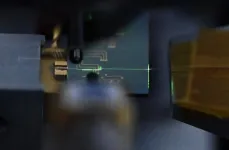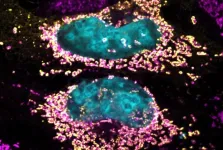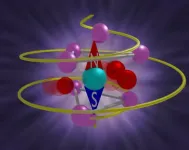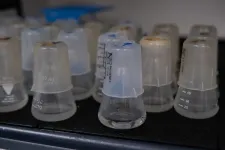(Press-News.org) Lasers have become relatively commonplace in everyday life, but they have many uses outside of providing light shows at raves and scanning barcodes on groceries. Lasers are also of great importance in telecommunications and computing as well as biology, chemistry, and physics research.
In those latter applications, lasers that can emit extremely short pulses—those on the order of one-trillionth of a second (one picosecond) or shorter—are especially useful. Using lasers operating on such small timescales, researchers can study physical and chemical phenomena that occur extremely quickly—for example, the making or breaking of molecular bonds in a chemical reaction or the movement of electrons within materials. These ultrashort pulses are also extensively used for imaging applications because they can have extremely large peak intensities but low average power, so they avoid heating or even burning up samples such as biological tissues.
In a paper appearing in the journal Science, Caltech's Alireza Marandi, an assistant professor of electrical engineering and applied physics, describes a new method developed by his lab for making this kind of laser, known as a mode-locked laser, on a photonic chip. The lasers are made using nanoscale components (a nanometer is one-billionth of a meter), allowing them to be integrated into light-based circuits similar to the electricity-based integrated circuits found in modern electronics.
"We're not just interested in making mode-locked lasers more compact," Marandi says. "We are excited about making a well-performing mode-locked laser on a nanophotonic chip and combining it with other components. That's when we can build a complete ultrafast photonic system in an integrated circuit. This will bring the wealth of ultrafast science and technology, currently belonging to meter-scale experiments, to millimeter-scale chips."
Ultrafast lasers of this sort are so important to research, that this year's Nobel Prize in Physics was awarded to a trio of scientists for the development of lasers that produce attosecond pulses (one attosecond is one-quintillionth of a second). Such lasers, however, are currently extremely expensive and bulky, says Marandi—who notes that his research is exploring methods to achieve such timescales on chips that can be orders of magnitude cheaper and smaller, with the aim of developing affordable and deployable ultrafast photonic technologies.
"These attosecond experiments are done almost exclusively with ultrafast mode-locked lasers," he says. "And some of them can cost as much as $10 million, with a good chunk of that cost being the mode-locked laser. We are really excited to think about how we can replicate those experiments and functionalities in nanophotonics."
At the heart of the nanophotonic mode-locked laser developed by Marandi's lab is lithium niobate, a synthetic salt with unique optical and electrical properties that, in this case, allows the laser pulses to be controlled and shaped through the application of an external radio-frequency electrical signal. This approach is known as active mode-locking with intracavity phase modulation.
"About 50 years ago, researchers used intracavity phase modulation in tabletop experiments to make mode-locked lasers and decided that it was not a great fit compared to other techniques," says Qiushi Guo, the first author of the paper and a former postdoctoral scholar in Marandi's lab. "But we found it to be a great fit for our integrated platform."
"Beyond its compact size, our laser also exhibits a range of intriguing properties. For example, we can precisely tune the repetition frequency of the output pulses in a wide range. We can leverage this to develop chip-scale stabilized frequency comb sources, which are vital for frequency metrology and precision sensing," adds Guo, who is now an assistant professor at the City University of New York Advanced Science Research Center.
Marandi says he aims to continue improving this technology so it can operate at even shorter timescales and higher peak powers, with a goal of 50 femtoseconds (a femtosecond is one-quadrillionth of a second), which would be a 100-fold improvement over his current device, which generates pulses 4.8 picoseconds in length.
The paper describing the research is titled "Ultrafast mode-locked laser in nanophotonic lithium niobite" and appears in the November 9 issue of Science. Co-authors are Benjamin K. Gutierrez (MS '23), graduate student in applied physics; electrical engineering graduate students Ryoto Sekine (MS '22), Robert M. Gray (MS '22), James A. Williams, Selina Zhou (BS '22), and Mingchen Liu; Luis Ledezma (PhD '23), an external affiliate in electrical engineering; Luis Costa, formerly at Caltech and now with JPL, which Caltech manages for NASA; and Arkadev Roy (MS '23, PhD '23), formerly of Caltech and now with UC Berkeley .
Funding for the research was provided by the Army Research Office, the National Science Foundation, and the Air Force Office of Scientific Research.
END
Ultrafast lasers on ultra-tiny chips
2023-11-09
ELSE PRESS RELEASES FROM THIS DATE:
Pesticides, herbicides, fungicides detected in New York state beeswax
2023-11-09
An analysis of beeswax in managed honeybee hives in New York found a wide variety of pesticide, herbicide and fungicide residues – exposing current and future generations of bees to long-term toxicity.
The study, published in the Journal of Veterinary Diagnostic Investigation, notes that people may be similarly exposed through contaminated honey, pollen and wax in cosmetics. Though the chemicals found in wax are not beneficial to humans, the small amounts in these products are unlikely to ...
Study reveals bacterial protein capable of keeping human cells healthy
2023-11-09
Researchers at the University of São Paulo (USP) in Brazil, partnering with colleagues in Australia, have identified a novel bacterial protein that can keep human cells healthy even when the cells have a heavy bacterial burden. The discovery could lead to new treatments for a wide array of diseases relating to mitochondrial dysfunction, such as cancer and auto-immune disorders. Mitochondria are organelles that supply most of the chemical energy needed to power cells’ biochemical reactions.
An article on the study is published in the journal PNAS. The researchers ...
Endangered thick-billed parrots at risk of losing newly identified, unprotected Sierra Madre forest habitats to logging, deforestation, study shows
2023-11-09
DOWNLOAD PHOTOS AND VIDEO: https://sandiegozoo.box.com/s/x50kzaoukdtyjxsv9mzqgn0fu1m6kddk
A binational team of scientists, using creativity and innovation, adorned dozens of endangered thick-billed parrots with tiny solar-powered satellite transmitters to track and reveal their winter migratory nesting sites in the remote treetops of the Sierra Madre Occidental ranges. Their research reveals new critical habitat, 80% of which has no formal protection.
In a study published this month in the journal Global ...
Atomic dance gives rise to a magnet
2023-11-09
Quantum materials hold the key to a future of lightning-speed, energy-efficient information systems. The problem with tapping their transformative potential is that, in solids, the vast number of atoms often drowns out the exotic quantum properties electrons carry.
Rice University researchers in the lab of quantum materials scientist Hanyu Zhu found that when they move in circles, atoms can also work wonders: When the atomic lattice in a rare-earth crystal becomes animated with a corkscrew-shaped vibration known as a chiral phonon, the crystal is transformed ...
Milky Way-like galaxy found in the early universe
2023-11-09
Using the James Webb Space Telescope, an international team, including astronomer Alexander de la Vega of the University of California, Riverside, has discovered the most distant barred spiral galaxy similar to the Milky Way that has been observed to date.
Until now it was believed that barred spiral galaxies like the Milky Way could not be observed before the universe, estimated to be 13.8 billion years old, reached half of its current age.
The research, published in Nature this week, was led by scientists at the Centro de Astrobiología in Spain.
“This galaxy, named ceers-2112, formed soon after ...
Side-effect avoiding treatment shows early promise against breast cancer in mice
2023-11-09
New experimental evidence suggests that substances known as narrow-spectrum Wnt signaling inhibitors—which could have fewer side effects than other related substances—are capable of suppressing the growth of breast cancer tumors in mice. Aina He of Shanghai Jiaotong University Affiliated Sixth People’s Hospital, China, and colleagues present these findings November 9th in the open access journal PLOS Biology.
While certain subtypes of breast cancer can be targeted with special medications, others can only be treated with standard chemotherapy. For some patients, chemotherapy may lead to the growth of stem cell-like cancer cells that are drug resistant. Previous ...
Bacteria-virus arms race provides rare window into rapid and complex evolution
2023-11-09
As conceived by Charles Darwin in the 1800s, evolution is a slow, gradual process during which species adaptations are inherited incrementally over generations. However, today biologists can see how evolutionary changes unfold on much more accelerated timescales.
Rather than the evocative plants and animals of the Galapagos Islands that Darwin studied in forming his theory of evolution, Postdoctoral Scholar Joshua Borin and Associate Professor Justin Meyer of UC San Diego’s School of Biological Sciences are documenting rapid evolutionary processes in simple laboratory flasks.
Borin ...
Open-science “COVID Moonshot” discovers new antivirals to treat COVID-19
2023-11-09
Although the group’s work has been freely available since its inception in March 2020, the COVID Moonshot Consortium is finally formally reporting their results. The COVID Moonshot – an open-science, crowdsourced, and patent-free drug discovery campaign targeting the SARS-CoV-2 virus – has yielded a wealth of data on the virus’s main protease, including insights that could pave the way for the development of new and better therapeutics. “The lead therapeutics described by [these researchers] may not be ready in time to affect the current pandemic, considering the timelines and challenges of drug approval,” write Brian Shoichet and Charles ...
Shrinking a mode-locked laser to the size of an optical chip
2023-11-09
Setting out to improve a technology that usually requires bulky, bench-top equipment, Quishi Guo and colleagues have shrunk a mode-locked laser (MLL) to the size of an optical chip with an integrated nanophotonic platform. The results show promise for developing ultrafast nanophotonic systems for a wide range of applications. Mode-locked lasers (MLLs) can produce coherent ultrashort pulses of light at extremely fast speeds – on the order of picoseconds and femtoseconds. These devices have enabled numerous technologies in photonics, including extreme nonlinear optics, two-photon microscopy, ...
Wildfire risk to US homes is rising, especially in western grasslands and shrublands
2023-11-09
Drawing on 30 years of data, researchers show that the number of homes within wildfire perimeters in the U.S. has doubled since the 1990s. This increasing risk is driven by both an increase in wildfires and the expansion of new homes into wildfire-prone areas, especially in the wildland-urban interface. Wildfire risks to homes are increasing, particularly in the wildland-urban interface (WUI), where houses and wildland vegetation are in close proximity. Over the last 12 years, more than 55,000 homes in the U.S. have been lost to wildfires due to rapid increases ...





